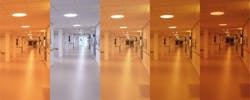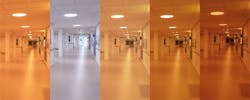Shift workers reported positive effects from working under amber lights, but not everyone agreed. Lighting for health and wellbeing continues to evolve.
Nurses from two Danish hospitals have reaffirmed that avoiding blue frequency light at night can help with sleep.
Interested in articles & announcements on human-centric lighting and health and wellbeing?
In a pilot deployment of specially-tuned circadian lights that stripped out blue wavelengths at night to create an amber hue, 26 nurses that worked under those lights generally reported a better quality of sleep than those in a control group that used conventional white illumination, which includes blue energy in the mix.
The nurses, at neurological wards at Aarhus University Hospital and Copenhagen University Hospital, kept diaries and responded to a survey run by the hospitals in partnership with Aarhus-based Chromaviso, which supplied the human-centric lighting system. All of the nurses worked at least one night shift per week.
The pilot was one of many early examples of the emerging concept of human-centric lighting, which calibrates lights at varying frequencies, spectral power, and intensities in order to suit different tasks or times of the day.
The circadian lighting from Chromaviso varies the hues across 24 hours.
As a nascent science, human-centric lighting — it also goes by other names including circadian lighting and lighting for health and wellbeing — is still characterized by a mix of conclusive and inconclusive observations regarding the absolute effect of different settings. The latest Danish study itself does not absolutely prove the sleep effectiveness of eliminating blue. As Aarhus clinical nursing specialist Leanne Langhorn noted, “We have received differing statements in the study, and therefore, the results are not clear-cut.”
But the overall set of responses and personal anecdotes suggested that the circadian system did indeed induce better sleep patterns.
“There is a tendency for nurses who have been exposed to circadian lighting to generally experience better sleep, as they fall asleep more easily and their sleep is calmer,” Langhorn said. “They generally find it easier to wake up in the morning and feel more rested after three days in circadian lighting, compared to the control group.”
One of the main links between blue light and sleep is that blue has been proven to suppress melatonin, a hormone related to sleep. Exposure to blue frequencies at night — such as from gadgets as well as from bulbs and luminaires — is thus generally regarded as something to avoid.
Conversely, blue light can also have a positive effect because it is known to release a pigment called melanopsin that stimulates the brain and is thus considered good for alertness during certain waking hours.
Along those lines, and on the detrimental side, some nurses in the Danish study reported that the amber circadian lights — those without blue frequencies — made them feel tired during night shifts when they needed to be wide awake.
“There have been a few that feel tired in the evening, because they need the stimulation from the white light,” said development nurse Lone Mathiesen from Copenhagen University Hospital. “Therefore, they have turned on one of the white lights in another room as needed.”
Chromaviso and the two hospitals have been very active in the human-centric lighting field. For example, Aarhus University Hospital has improved sleep for brain trauma patients using Chromaviso lighting.
Chromaviso is also piloting circadian lighting with dementia patients at the Plejecentret Albertshøj care home in Albertslund, Denmark, and has reduced drug reliance among psychiatric patients at the Aabenraa Psychiatric Hospital.
While hospitals and healthcare settings are considered ideal proving grounds for human-centric lighting — in part because the preponderance of monitoring equipment can help measure results — schools and commercial workplaces are beginning to deploy the concept, such as at the headquarters for the American Society of Interior Designers (ASID) in Washington, DC and the Bullitt Center in Seattle; at various General Services Administration buildings in the US; at Miami-Dade County Public Schools; and at many other locations.
Meanwhile, in an example of the still-inconclusive state of circadian lighting, one recent small study by Rensselaer Polytechnic Institute's Lighting Research Center surprisingly found that the wavelength was not a factor in whether iPads kept users up at night, whereas other factors such as screen brightness and mental stimulation were more complicit.
MARK HALPERis a contributing editor for LEDs Magazine, and an energy, technology, and business journalist ([email protected]).
Subscribe to LEDs Magazine and look for a September report from Maury Wright on the latest scientific studies presented at the July Lighting for Health and Wellbeing Conference, hosted by LEDs Magazine.






